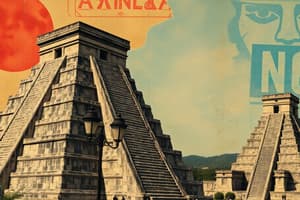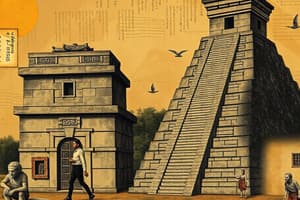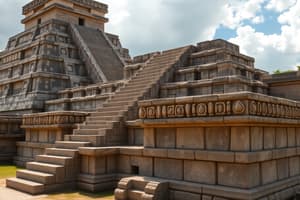Podcast
Questions and Answers
What major factor is believed to have contributed to the decline of the Mayan civilization?
What major factor is believed to have contributed to the decline of the Mayan civilization?
- Strong military alliances
- Cultural assimilation
- Technological advancement
- Overpopulation (correct)
How did the Aztecs primarily accumulate wealth for their civilization?
How did the Aztecs primarily accumulate wealth for their civilization?
- Through diplomatic negotiations
- Through agriculture alone
- By conducting trade exclusively
- By extracting tribute from conquered peoples (correct)
Which deity was considered the most important in Aztec religion?
Which deity was considered the most important in Aztec religion?
- Quetzalcoatl
- Tlaloc
- Tezcatlipoca
- Huitzilopochtli (correct)
What was a key agricultural aspect that the Aztecs managed to develop?
What was a key agricultural aspect that the Aztecs managed to develop?
What ritual practice was commonly performed by the Aztecs to maintain cosmic balance?
What ritual practice was commonly performed by the Aztecs to maintain cosmic balance?
During which time period did the Classic Maya civilization flourish?
During which time period did the Classic Maya civilization flourish?
Which calendar system did the Aztecs employ that included 18 months of 20 days each?
Which calendar system did the Aztecs employ that included 18 months of 20 days each?
What was the population size of the Aztec capital, Tenochtitlan, at its peak?
What was the population size of the Aztec capital, Tenochtitlan, at its peak?
What civilization is referred to as the 'mother culture' of Mesoamerica?
What civilization is referred to as the 'mother culture' of Mesoamerica?
During which period did the Maya reach their peak power?
During which period did the Maya reach their peak power?
Which ancient Maya achievement is specifically mentioned as being constructed using advanced architectural techniques?
Which ancient Maya achievement is specifically mentioned as being constructed using advanced architectural techniques?
What was significant about corn in Maya mythology?
What was significant about corn in Maya mythology?
What concept did the Maya develop as part of their sophisticated numerical system?
What concept did the Maya develop as part of their sophisticated numerical system?
What did the ancient Mayans use as currency, according to recent studies?
What did the ancient Mayans use as currency, according to recent studies?
Which types of corn did the Maya believe contributed to the physical aspects of human beings according to their mythology?
Which types of corn did the Maya believe contributed to the physical aspects of human beings according to their mythology?
What burial practice did the ancient Mayans commonly perform?
What burial practice did the ancient Mayans commonly perform?
Which innovation allowed the Aztecs to cultivate crops in marshy lands?
Which innovation allowed the Aztecs to cultivate crops in marshy lands?
What major factor contributed to the decline of the Aztec population following the arrival of Hernán Cortés?
What major factor contributed to the decline of the Aztec population following the arrival of Hernán Cortés?
What was a significant engineering achievement of the Aztecs in Tenochtitlan?
What was a significant engineering achievement of the Aztecs in Tenochtitlan?
Which of the following best describes the legacy of the ancient Mesoamerican civilizations?
Which of the following best describes the legacy of the ancient Mesoamerican civilizations?
How did the network of roads and canals benefit the Aztec Empire?
How did the network of roads and canals benefit the Aztec Empire?
In what year did the fall of Tenochtitlan occur, marking the end of the Aztec Empire?
In what year did the fall of Tenochtitlan occur, marking the end of the Aztec Empire?
What was one of the cultural contributions of the Olmec and Maya to later Mesoamerican societies?
What was one of the cultural contributions of the Olmec and Maya to later Mesoamerican societies?
What aspect of indigenous communities today reflects the influence of ancient Mesoamerican civilizations?
What aspect of indigenous communities today reflects the influence of ancient Mesoamerican civilizations?
What was the Olmec civilization primarily known for?
What was the Olmec civilization primarily known for?
What is the significance of the term 'Mesoamerica'?
What is the significance of the term 'Mesoamerica'?
How did the Olmec civilization influence later Mesoamerican cultures?
How did the Olmec civilization influence later Mesoamerican cultures?
What were the Olmecs known to use rubber for?
What were the Olmecs known to use rubber for?
What type of counting system did the Olmecs develop?
What type of counting system did the Olmecs develop?
What material was particularly valued by the Olmec civilization?
What material was particularly valued by the Olmec civilization?
Which of the following features distinguishes the giant heads created by the Olmecs?
Which of the following features distinguishes the giant heads created by the Olmecs?
What progression did the Olmec writing system undergo?
What progression did the Olmec writing system undergo?
Flashcards are hidden until you start studying
Study Notes
Olmec Civilization (1500-400 BC)
- Considered the "mother culture" of Mesoamerica, influencing later civilizations like the Maya and Aztec.
- Known for impressive stone heads, intricate carvings, and advanced astronomical knowledge.
- Name derived from the Aztec word for "rubber people," reflecting their rubber production from rubber trees, used for ritualistic ball games.
- Developed the first written language and numbering system in Mesoamerica.
- Created significant artifacts, including jade masks and colossal stone heads.
- Utilized a vigesimal (base-20) counting system, with bars representing 5 and dots representing 1.
Mayan Civilization (250-900 CE)
- Flourished in present-day Mexico, Guatemala, Belize, and Honduras.
- Classical Period (250-900 CE) saw peak power, with large cities and advancements in mathematics and astronomy.
- Master builders, constructing pyramids, temples, palaces, and ball courts using advanced techniques.
- Developed a sophisticated numerical system, including zero, and made significant advancements in astronomy and calendar-making.
- Corn held significant cultural and religious importance; Mayan mythology describes humans being created from different types of corn.
- Practiced both burial and cremation, placing corn in the deceased's mouth to symbolize rebirth.
- Used cacao beans as currency during the Classic Maya period.
- Decline attributed to overpopulation, environmental degradation, warfare, and climate change.
Aztec Empire (14th-16th Century)
- Originated as a nomadic tribe, settling in the Valley of Mexico.
- Rose to power through military conquest and alliances, creating a vast empire by the 15th century.
- Tenochtitlan, their capital, was a large and impressive city with a population exceeding 200,000.
- Empire maintained through a tribute system, extracting resources from conquered peoples.
- Revered the Sun God, Huitzilopochtli, and practiced elaborate rituals, including human sacrifice.
- Had a complex calendar system composed of a 260-day ritual calendar, a 365-day solar calendar, and an 18-month calendar with 20 days each.
- Skilled astronomers, closely observing celestial movements.
- Developed chinampas (floating gardens), aqueducts, and extensive road and canal networks.
- Conquered by Hernán Cortés in 1521, due to factors including disease, internal conflict, and Spanish military tactics.
Legacy of Olmec, Mayan, and Aztec Civilizations
- Enduring cultural influence on art, architecture, mathematics, and religious beliefs.
- Archaeological treasures continue to provide insights into their advanced nature.
- Many indigenous communities still maintain traditions tracing back to these ancient civilizations.
Studying That Suits You
Use AI to generate personalized quizzes and flashcards to suit your learning preferences.




